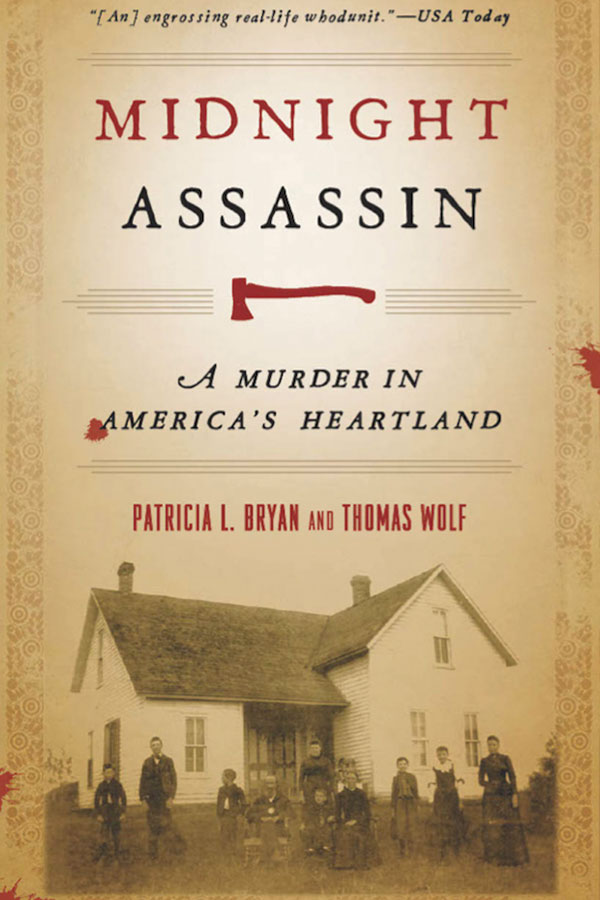
In his senior year, Tom Wolf ’69 took a writing class with a new, young faculty member, Robin Metz, the co-founder and later the director of Knox’s Program in Creative Writing. After graduating from Knox, Wolf was a VISTA volunteer on Long Island. In 1973, he entered the M.F.A. program at the Iowa Writers’ Workshop, where he studied with Raymond Carver and John Irving. He taught English in the ’70s and ’80s at Carl Sandburg College in Galesburg, eventually moving to Chapel Hill, North Carolina, where he met his wife, Patricia Bryan.
Bryan and Wolf have co-authored two historical true crime books: Midnight Assassin: A Murder in America’s Heartland (Algonquin Books of Chapel Hill, 2005) and the recently published The Plea: The True Story of Young Wesley Elkins and His Struggle for Redemption (University of Iowa Press, 2022).
Why the interest in the story of Wesley Elkins?
Our first true crime book, Midnight Assassin, tells the story of Margaret Hossack, an Iowa farmer’s wife who was accused and convicted of murdering her husband in 1900. That crime inspired the writer Susan Glaspell—who reported on the trial for the Des Moines Daily News—to write two of her most famous works: the classic one-act play Trifles and the much-anthologized short story “A Jury of Her Peers.”
During our research into the Hossack case, we discovered the story of Wesley Elkins. Wesley had admitted to killing his abusive father and stepmother. The crime occurred in 1889. Wesley’s story was unique in that he was a small child at the time he committed his crime. After confessing, he was sentenced to life in the adult prison at Anamosa State Penitentiary in Iowa.
What happened to Wesley in prison—and how he lived his life after he gained his release in 1902—is truly exceptional and heartening. He was nurtured and supported in prison by progressive prison wardens, teachers, and the prison chaplain. Wesley was assigned to work in the prison library, where he developed a love of reading and educated himself. He wrote many eloquent letters to educators, politicians, and newspaper editors asking for a reconsideration of his sentence. Eventually, he was paroled and lived a long life as a responsible citizen.
Your other books have been about baseball. Why the interest in true crime books?
The two true crime books—Midnight Assassin and The Plea—are centered on murders that shocked local communities in Iowa more than a hundred years ago, but both of those books have a broader context and raise questions about the legal system, crime and punishment, the way stories are told, and the complexity of family relationships. The baseball books focus on the stories of individual seasons and players like Rogers Hornsby and Babe Ruth who played in the 1920s and 1930s. Those were great years for baseball and very challenging years for the country.
What does your wife do?
Patricia is a professor of law at the University of North Carolina School of Law. She teaches courses in basic tax, corporate tax, and a seminar in Law and Literature. Her interest in literature, and especially in the works of Glaspell, got us involved in the research for the book Midnight Assassin.
For our books, we divide up the research and writing, composing first drafts of separate chapters, and then we exchange the drafts to revise and edit. After many drafts back and forth, the material is shaped into a narrative that is true to the historical facts, and, hopefully, engaging to readers.
How did you end up at Knox?
I grew up in Granville, Ohio, where my father was a college professor at Denison University. My mother had encouraged my interest in reading and writing, and I knew Knox had a strong writing program. It was always in my mind that I was going to go to a small college somewhere. I applied for early admission and was accepted just before Christmas. Knox was the only school I applied to.
Tell us about Robin Metz’s influence on you.
Robin had a tremendous influence on me and on many of us who took his classes. He was only a few years older than most of us at that time, and he was a terrific teacher, charismatic and supportive. Without Robin’s encouragement, I doubt that I would have gone to graduate school at the University of Iowa or pursued a career as a teacher.
I heard Robin read his short story “Doughboy” to a packed audience in Founder’s Lounge. It was a mesmerizing reading—both the story itself and Robin’s dramatic reading of it. I think it’s the first time I’d heard a work of fiction read out loud. It made me aware of the power of both words and performance, and it’s why I registered for Robin’s classes the following year.
Wolf has also published articles on baseball literature and history and is the author of The Called Shot: Babe Ruth, the Chicago Cubs and the Unforgettable Major League Baseball Season of 1932 (University of Nebraska Press, 2020). He is currently working on a history of the 1926 major league baseball season, tentatively titled Baseball in the Roaring Twenties: Babe Ruth’s Yankees, Roger Hornsby’s Cardinals, and the Summer of 1926.